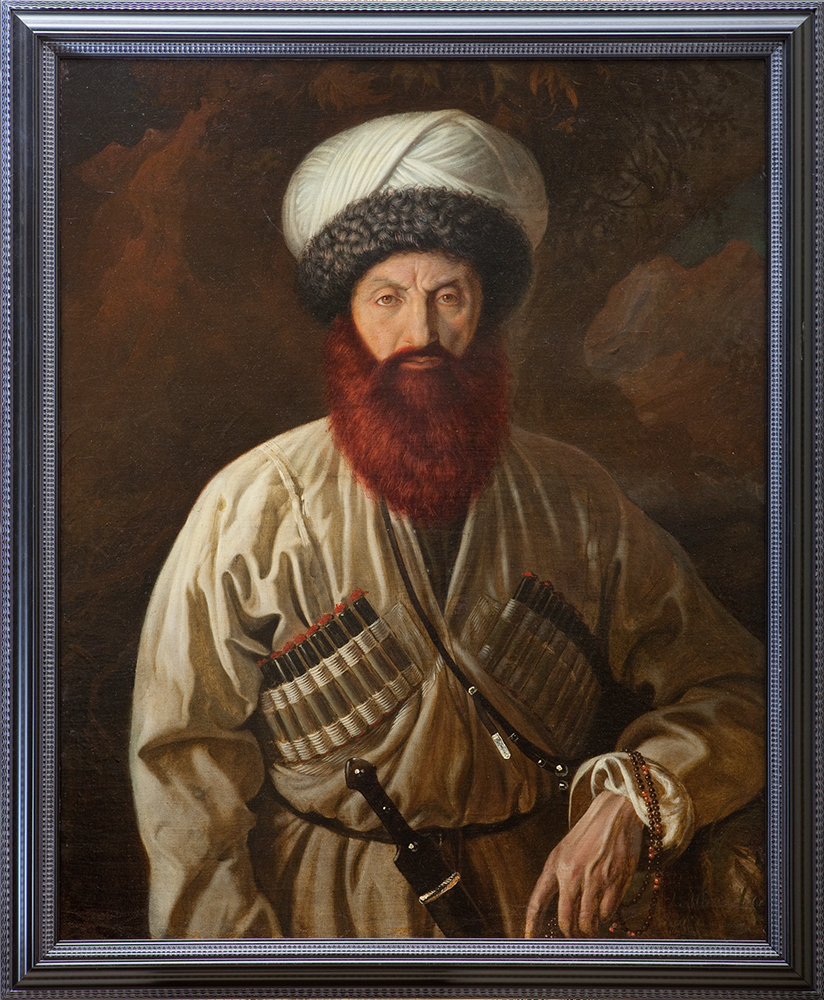Portrait of Shamil

Shamil (1797–1871) Imam, the head of the Caucasus Imamate, theocratic state which was formed in the course of national liberation struggle of mountaineers in 1820–1860’s. Being a wise politician and a good military commander, Shamil had led the struggle of people of Dagestan and Chechnya against Russia for 25 years. He reached the peak of his military success in 1840’s, but in 1850’s his Imamate lost power and territory. In 1859 Shamil was surrounded in Gunib by Emperor’s troops under the command of General A.I.Baryatinsky and was forced to capitulate.
According to witnesses, the captured Shamil said the following to Baryatinsky: “I have fought for religion for thirty years, but now I am betrayed by my people, and naibs have gone, and I myself am tired… I congratulate you on your dominion over Dagestan and I really wish His Majesty success in governing the mountaineers for their good”.
A prisoner, Shamil was accorded the honors worthy of a head of a defeated state. Kaluga was appointed the place of his honorary exile. In 1866 Shamil swore an allegiance to Russia. In 1869 he wrote a letter to Emperor asking let him go on a pilgrimage to Mecca and Medina. After receiving the positive response, in March 1870 he left Russia. Shamil died in Medina at the age of 74.
Emmanuil Alexandrovich Dmitriev-Mamonov (1824–1883), author of the only ceremonial portrait of Shamil, the 3rd Imam of Dagestan and Chechnya. He received the elementary art education from his father Major General A.I.Dmitryev-Mamonov who was a draftsman and painter, director of the Military topographic depot; in 1850’s he studied at the Moscow School of Painting and Sculpture.
Was the portrait of Shamil made from life? Imam was brought to Kaluga on October 10, 1859. On the lithograph portraits made by that time, the famous prisoner was shown exactly as he was in September 1859 when he arrived in Saint Petersburg. There, the artist and publisher Wilhelm Timm (1820–1895) accompanied Shamil in his walks and made sketches in a theatre, in the Public library, in a carriage going down Nevsky Prospect, visiting professor Kazem-Bek or the 1st Cadet Corps where Shamil’s elder son Jamaluddin was brought up.
On the eve of prisoner’s departure for Kaluga W.Timm was allowed “to make the final portrait” of Shamil. Timm’s work is a completed portrait of Imam, later it was published in “Russian Art Gazette” and other print editions on the Caucasus. According to its composition and details of clothing, this work is exactly the one which became a prototype for the painted ceremonial portrait made by Dmitryev-Mamonov.
